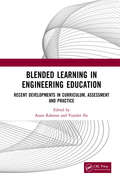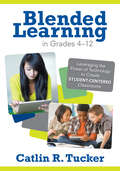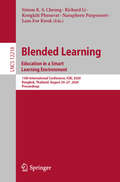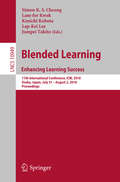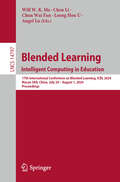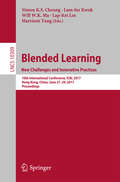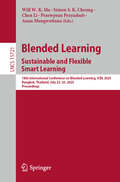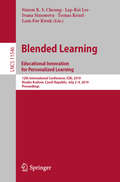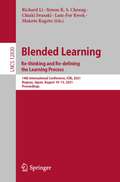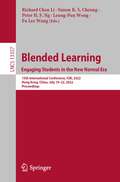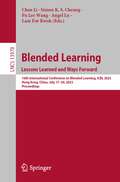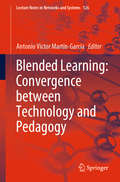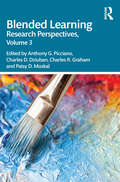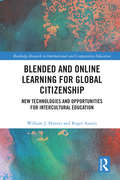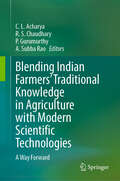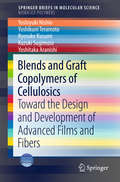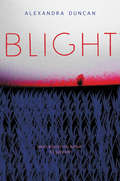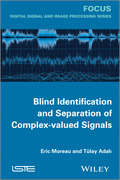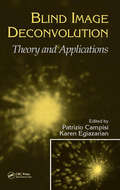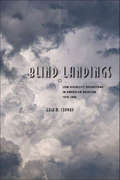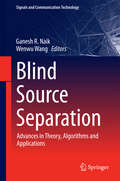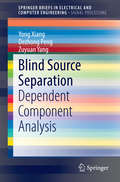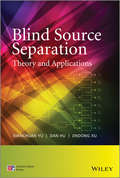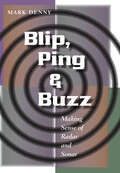- Table View
- List View
Blended Learning in Engineering Education: Recent Developments in Curriculum, Assessment and Practice
by Ataur Rahman Vojislav IlicBlended Learning combines the conventional face-to-face course delivery with an online component. The synergetic effect of the two modalities has proved to be of superior didactic value to each modality on its own. The highly improved interaction it offers to students, as well as direct accessibility to the lecturer, adds to the hitherto unparalleled learning outcomes. "Blended Learning in Engineering Education: Recent Developments in Curriculum, Assessment and Practice" highlights current trends in Engineering Education involving face-to-face and online curriculum delivery. This book will be especially useful to lecturers and postgraduate/undergraduate students as well as university administrators who would like to not only get an up-to-date overview of contemporary developments in this field, but also help enhance academic performance at all levels.
Blended Learning in Grades 4–12: Leveraging the Power of Technology to Create Student-Centered Classrooms
by Catlin R. TuckerUse technology to focus on your students! In this step-by-step guide, teacher and education blogger Catlin Tucker outlines the process for integrating online discussion with face-to-face instruction in a way that empowers teachers to focus their energies where they’re most needed. With concrete strategies, ready-to-use resources, and sample rubrics grounded in the Common Core State Standards, this book shows teachers how to: Increase engagement and drive higher-order thinking Prepare students for high-stakes exams without sacrificing class time Assess online work Personalize learning and differentiate lessons Move toward flipped instruction to create a student-centered classroom
Blended Learning. Education in a Smart Learning Environment: 13th International Conference, ICBL 2020, Bangkok, Thailand, August 24–27, 2020, Proceedings (Lecture Notes in Computer Science #12218)
by Richard Li Simon K. S. Cheung Kongkiti Phusavat Naraphorn Paoprasert Lam‑For KwokThis book constitutes the refereed proceedings of the 13th International Conference on Blended Learning, ICBL 2020, held in Bangkok, in August 2020.The 33 papers presented were carefully reviewed and selected from 70 submissions. The conference theme of ICBL 2020 is Blended Learning : Education in a Smart Learning Environment. The papers are organized in topical sections named: Blended Learning, Hybrid Learning, Online Learning, Enriched and Smart Learning, Learning Management System and Content and Instructional Design.
Blended Learning. Enhancing Learning Success: 11th International Conference, ICBL 2018, Osaka, Japan, July 31- August 2, 2018, Proceedings (Lecture Notes in Computer Science #10949)
by Simon K.S. Cheung Lam-For Kwok Lap-Kei Lee Kenichi Kubota Jumpei TokitoThis book constitutes the refereed proceedings of the 11th International Conference on Blended Learning, ICBL 2018, held in Osaka, Japan, in July/ August 2018.The 35 papers presented were carefully reviewed and selected from 94 submissions. The papers are organized in topical sections named: Experiences in Blended Learning, Content Development for Blended Learning, Assessment for Blended Learning, Computer-Support Collaborative Learning, Improved Flexibility of Learning Processes, Open Educational Resources, and Pedagogical and Psychological Issues.
Blended Learning. Intelligent Computing in Education: 17th International Conference on Blended Learning, ICBL 2024, Macao SAR, China, July 29 – August 1, 2024, Proceedings (Lecture Notes in Computer Science #14797)
by Will W. K. Ma Leong Hou U Chen Li Angel Lu Chun Wai FanThis book constitutes the refereed proceedings of the 17th International Conference on Blended Learning. Intelligent Computing in Education, ICBL 2024, held in Macao, China, during July 29 - August 1, 2024. The 26 papers presented in this volume were carefully reviewed and selected from 71 submissions. The selected papers are classified into four primary themes: revolutionizing education with AI; blended learning and technological innovations; advancements in learning analytics; and innovative approaches in educational research.
Blended Learning. New Challenges and Innovative Practices: 10th International Conference, ICBL 2017, Hong Kong, China, June 27-29, 2017, Proceedings (Lecture Notes in Computer Science #10309)
by Will W.K. Ma Simon K.S. Cheung Lam-For Kwok Harrison Yang Lap-Kei LeeThis book constitutes the refereed proceedings of the 10th International Conference on Blended Learning, ICBL 2017, held in Hong Kong, China, in June 2017. The 42 papers presented were carefully reviewed and selected from 100 submissions. The papers are organized in topical sections named: Keynotes; Experiences in Blended Learning; Strategies in Blended Learning; Assessment for Blended Learning; Computer-Support Collaborative Learning; Improved Flexibility of Learning Processes; Open Educational Resources; Pedagogical and Psychological Issues.
Blended Learning. Sustainable and Flexible Smart Learning: 18th International Conference on Blended Learning, ICBL 2025, Bangkok, Thailand, July 22-25, 2025, Proceedings (Lecture Notes in Computer Science #15721)
by Will W. K. Ma Chen Li Simon S. K. Cheung Praewpran Prayadsab Anan MungwattanaThis book constitutes the refereed proceedings of the 18th International Conference on Blended Learning, ICBL 2025, held in Bangkok, Thailand, during July 22-25, 2025. The 24 full papers included in this book were carefully reviewed and selected from 60 submissions. They were organized in topical sections as follows: Keynotes, AI and Robotics in Education, Innovative Teaching Methods in Blended Learning, Pedagogical Strategies and Student Engagement, Evaluation and Feedback in Blended Learning, Data-Driven Learning Analytics and Context-Aware Systems.
Blended Learning: 12th International Conference, ICBL 2019, Hradec Kralove, Czech Republic, July 2–4, 2019, Proceedings (Lecture Notes in Computer Science #11546)
by Lam-For Kwok Lap-Kei Lee Simon K. Cheung Ivana Simonova Tomas KozelThis book constitutes the refereed proceedings of the 12th International Conference on Blended Learning, ICBL 2019, held in Hradec Kralove, Czech Republic, in July 2019. The 28 papers presented were carefully reviewed and selected from 80 submissions. The papers are organized in topical sections named: personalized and adaptive learning; content development for blended learning; experience in blended learning; analytics and evaluation for blended learning; open educational resources; and pedagogical and psychological issues.
Blended Learning: 14th International Conference, ICBL 2021, Nagoya, Japan, August 10–13, 2021, Proceedings (Lecture Notes in Computer Science #12830)
by Lam-For Kwok Richard Li Simon K. S. Cheung Chiaki Iwasaki Makoto KagetoThis book constitutes the refereed proceedings of the 14th International Conference on Blended Learning, ICBL 2021, held online in August 2021. The 30 papers, including 4 keynote papers, were carefully reviewed and selected from 79 submissions. The conference theme of ICBL 2021 is Blended Learning: Re-thinking and Re-defining the Learning Process. The papers are organized in topical sections named: content and instructional design; enriched and smart learning experience; experience in blended learning; institutional policies and strategies; and online and collaborative learning.
Blended Learning: 15th International Conference, ICBL 2022, Hong Kong, China, July 19–22, 2022, Proceedings (Lecture Notes in Computer Science #13357)
by Fu Lee Wang Simon K. S. Cheung Richard Chen Li Peter H. F. Ng Leung-Pun WongThis book constitutes the refereed proceedings of the 15th International Conference on Blended Learning, ICBL 2022, held in Hong Kong, China, in August 2022. The 31 papers presented in this volume were carefully reviewed and selected from 80 submissions. The conference theme of ICBL 2022 is Blended Learning: Engaging Students in the New Era. The papers are organized in topical sections named: Game-based Learning and Augmented Learning Environment; Computer Supported Collaborative Learning; Enriching Learning Experience with Blended and Online Learning; Content Development and Practice for Blended Learning and Beyond.
Blended Learning: 16th International Conference on Blended Learning, ICBL 2023, Hong Kong, China, July 17-20, 2023, Proceedings (Lecture Notes in Computer Science #13978)
by Fu Lee Wang Chen Li Simon K. S. Cheung Lam For Kwok Angel LuThis book constitutes the refereed proceedings of the 16th International Conference on Blended Learning, ICBL 2023, held in Hong Kong, China, on July 17-20, 2023. The 24 papers presented in this volume were carefully reviewed and selected from 57 submissions. The papers are organized in topical sections named: smart classroom and digital literacy; online and distant learning; content and pedagogy development for blended learning; gamification and lnteractive learning snvironment; learning analytics and big data in education.
Blended Learning: Convergence between Technology and Pedagogy (Lecture Notes in Networks and Systems #126)
by Antonio Víctor Martín-GarcíaThis book focuses on essential aspects of the theoretical foundations that support blended learning (BL) as a teaching training modality in tertiary education. Analyzing the changes in the world of education that lead to new ways of thinking and learning, it redefines the concept of blended learning at a time of constant growth in many universities around the world. This involves a shared reflection on the role of technology in the current university teacher education programs, as well as on the role that pedagogy plays in increasingly technology-driven contexts. Furthermore, the book presents pedagogical approaches to guide university professors in the design and implementation of blended learning courses. To this end, it describes some of the major models and approaches to BL instructional design, and examines issues related to the quality of BL training and the indicators to measure it, in order to identify those models that contribute to a better understanding of the dimensions that increase its effectiveness.
Blended Learning: Research Perspectives, Volume 3
by Charles R. Graham Anthony G. Picciano Charles D. Dziuban Patsy D. MoskalBlended Learning: Research Perspectives, Volume 3 offers new insights into the state of blended learning, an instructional modality that combines face-to-face and digitally mediated experiences. Education has recently seen remarkable advances in instructional technologies such as adaptive and personalized instruction, virtual learning environments, gaming, analytics, and big data software. This book examines how these and other evolving tools are fueling advances in our schools, colleges, and universities. Original scholarship from education’s top thinkers will prepare researchers and learning designers to tackle major issues relating to learning effectiveness, diversity, economies of scale, and beyond.
Blended and Online Learning for Global Citizenship: New Technologies and Opportunities for Intercultural Education (Routledge Research in International and Comparative Education)
by Roger Austin William J. HunterBy showcasing international, European, and community-based projects, this volume explores how online technologies and collaborative and blended learning can be used to bolster social cohesion and increase students’ understanding of what it means to be a global citizen. With the pace of technology rapidly increasing, Blended and Online Learning for Global Citizenship draws timely attention to the global lessons being learned from the impact of these technologies on peace building, community development, and acceptance of difference. In-depth case studies showcasing successful projects in Europe, Northern Ireland, and Israel explore blended learning and illustrate how schools and educators have embraced online technologies to foster national and international links both within and beyond communities. This has, in turn, equipped students with experiences that have informed their attitudes to cultural and political conflicts, as well as racial, ethnic, and social diversity. Building on the authors’ previous work Online Learning and Community Cohesion (2013), this thought-provoking text will be of interest to researchers, academics, and postgraduate students in the fields of international and comparative education. Educators and school leaders concerned with how multiculturalism and technology play out in the classroom environment will also benefit from reading this text.
Blending Indian Farmers' Traditional Knowledge in Agriculture with Modern Scientific Technologies: A Way Forward
by C. L. Acharya R. S. Chaudhary P. Gurumurthy A. Subba RaoThis book is a compilation of 37 chapters covering various agro ecosystems of India with respect to Indian farmers’ traditional knowledge and technology in agriculture specifically in nutrient management, crop production, water management and conservation, soil conservation and plant protection, which have been passed on from one generation to other since centuries. The book explains the scopes of blending this traditional knowledge with modern scientific technologies in agriculture with an aim of reducing production cost, improving soil health and use efficiency of costly market purchased inputs, water conservation and better environment. In the present era of continued degradation of natural resources of India, (primarily soil, water, and nutrients), falling soil health, poor use efficiency of agricultural inputs like fertilizer nutrients imported/ purchased at huge costs, it has become a big challenge to maintain the food production and simultaneously to sustain the soil health and productivity. The problem is further made complex by the changing climate, high levels of soil erosion and rising demands of ever-increasing population of the country for food, fodder, fibre, and fuel. In the face of such an alarming situation, the blending of low-cost traditional knowledge of Indian farmers and use of locally available inputs/ resources with the modern scientific technologies in agriculture, is seen as a major hope in increasing the input use efficiency, protection/conservation of the soil, water and nutrients towards sustainable crop production and food security without compromising the soil health. The book will be of interest to the scientists/researchers, extension workers, capacity builders, planners, government administrators, teachers, and students.
Blends and Graft Copolymers of Cellulosics: Toward the Design and Development of Advanced Films and Fibers (SpringerBriefs in Molecular Science)
by Yoshiyuki Nishio Yoshikuni Teramoto Ryosuke Kusumi Kazuki Sugimura Yoshitaka AranishiThis book reveals how polymer blending and grafting now offer a growing range of new applications for advanced films and fibers. Further, it details how the processing and original physical properties of cellulosics can be improved, and demonstrates how new, cellulose-core polymeric materials offer a wide range of synergistic functionalities. Lastly, it summarizes basic characterization studies and successful fabrications of advanced films and fibers. The book is primarily intended for advanced undergraduates, academic and industrial researchers and professionals studying or using bio-based polymers.
Blight
by Alexandra DuncanWhen an agribusiness facility producing genetically engineered food releases a deadly toxin into the environment, seventeen-year-old Tempest Torres races to deliver the cure before time runs out.From the author of the acclaimed American Booksellers Association’s Indies Introduce pick Salvage, which was called “Brilliant, feminist science fiction” by Stephanie Perkins, the internationally bestselling author of Anna and the French Kiss. This stand-alone action-adventure story is perfect for fans of Oryx and Crake and The House of the Scorpion. Seventeen-year-old Tempest Torres has lived on the AgraStar farm north of Atlanta, Georgia, since she was found outside its gates at the age of five. Now she’s part of the security force guarding the fence and watching for scavengers—people who would rather steal genetically engineered food from the Company than work for it. When a group of such rebels accidentally sets off an explosion in the research compound, it releases into the air a blight that kills every living thing in its path—including humans. With blight-resistant seeds in her pocket, Tempest teams up with a scavenger boy named Alder and runs for help. But when they finally arrive at AgraStar headquarters, they discover that there’s an even bigger plot behind the blight—and it’s up to them to stop it from happening again.Inspired by current environmental issues, specifically the genetic adjustment of seeds to resist blight and the risks of not allowing natural seed diversity, this is an action-adventure story that is Margaret Atwood’s Oryx and Crake meets Nancy Farmer’s House of the Scorpion.
Blind Equalization and Identification (Signal Processing and Communications)
by Zhi Ding Ye LiThis text seeks to clarify various contradictory claims regarding capabilities and limitations of blind equalization. It highlights basic operating conditions and potential for malfunction. The authors also address concepts and principles of blind algorithms for single input multiple output (SIMO) systems and multi-user extensions of SIMO equalization and identification.
Blind Identification and Separation of Complex-valued Signals
by Eric Moreau Tülay AdaliBlind identification consists of estimating a multi-dimensional system only through the use of its output, and source separation, the blind estimation of the inverse of the system. Estimation is generally carried out using different statistics of the output. The authors of this book consider the blind identification and source separation problem in the complex-domain, where the available statistical properties are richer and include non-circularity of the sources – underlying components. They define identifiability conditions and present state-of-the-art algorithms that are based on algebraic methods as well as iterative algorithms based on maximum likelihood theory. Contents 1. Mathematical Preliminaries. 2. Estimation by Joint Diagonalization. 3. Maximum Likelihood ICA. About the Authors Eric Moreau is Professor of Electrical Engineering at the University of Toulon, France. His research interests concern statistical signal processing, high order statistics and matrix/tensor decompositions with applications to data analysis, telecommunications and radar. Tülay Adali is Professor of Electrical Engineering and Director of the Machine Learning for Signal Processing Laboratory at the University of Maryland, Baltimore County, USA. Her research interests concern statistical and adaptive signal processing, with an emphasis on nonlinear and complex-valued signal processing, and applications in biomedical data analysis and communications. Blind identification consists of estimating a multidimensional system through the use of only its output. Source separation is concerned with the blind estimation of the inverse of the system. The estimation is generally performed by using different statistics of the outputs. The authors consider the blind estimation of a multiple input/multiple output (MIMO) system that mixes a number of underlying signals of interest called sources. They also consider the case of direct estimation of the inverse system for the purpose of source separation. They then describe the estimation theory associated with the identifiability conditions and dedicated algebraic algorithms. The algorithms depend critically on (statistical and/or time frequency) properties of complex sources that will be precisely described.
Blind Image Deconvolution: Theory and Applications
by Patrizio Campisi Karen EgiazarianBlind image deconvolution is constantly receiving increasing attention from the academic as well the industrial world due to both its theoretical and practical implications. The field of blind image deconvolution has several applications in different areas such as image restoration, microscopy, medical imaging, biological imaging, remote sensing, astronomy, nondestructive testing, geophysical prospecting, and many others. Blind Image Deconvolution: Theory and Applications surveys the current state of research and practice as presented by the most recognized experts in the field, thus filling a gap in the available literature on blind image deconvolution.Explore the gamut of blind image deconvolution approaches and algorithms that currently exist and follow the current research trends into the future. This comprehensive treatise discusses Bayesian techniques, single- and multi-channel methods, adaptive and multi-frame techniques, and a host of applications to multimedia processing, astronomy, remote sensing imagery, and medical and biological imaging at the whole-body, small-part, and cellular levels. Everything you need to step into this dynamic field is at your fingertips in this unique, self-contained masterwork.For image enhancement and restoration without a priori information, turn to Blind Image Deconvolution: Theory and Applications for the knowledge and techniques you need to tackle real-world problems.
Blind Landings: Low-Visibility Operations in American Aviation, 1918–1958
by Erik M. ConwayWhen darkness falls, storms rage, fog settles, or lights fail, pilots are forced to make "instrument landings," relying on technology and training to guide them through typically the most dangerous part of any flight. In this original study, Erik M. Conway recounts one of the most important stories in aviation history: the evolution of aircraft landing aids that make landing safe and routine in almost all weather conditions. Discussing technologies such as the Loth leader-cable system, the American National Bureau of Standards system, and, its descendants, the Instrument Landing System, the MIT-Army-Sperry Gyroscope microwave blind landing system, and the MIT Radiation Lab's radar-based Ground Controlled Approach system, Conway interweaves technological change, training innovation, and pilots' experiences to examine the evolution of blind landing technologies. He shows how systems originally intended to produce routine, all-weather blind landings gradually developed into routine instrument-guided approaches. Even so, after two decades of development and experience, pilots still did not want to place the most critical phase of flight, the landing, entirely in technology's invisible hand. By the end of World War II, the very concept of landing blind therefore had disappeared from the trade literature, a victim of human limitations.
Blind Source Separation: Advances in Theory, Algorithms and Applications (Signals and Communication Technology)
by Ganesh R. Naik Wenwu WangBlind Source Separation intends to report the new results of the efforts on the study of Blind Source Separation (BSS). The book collects novel research ideas and some training in BSS, independent component analysis (ICA), artificial intelligence and signal processing applications. Furthermore, the research results previously scattered in many journals and conferences worldwide are methodically edited and presented in a unified form. The book is likely to be of interest to university researchers, R&D engineers and graduate students in computer science and electronics who wish to learn the core principles, methods, algorithms and applications of BSS. Dr. Ganesh R. Naik works at University of Technology, Sydney, Australia; Dr. Wenwu Wang works at University of Surrey, UK.
Blind Source Separation: Dependent Component Analysis (SpringerBriefs in Electrical and Computer Engineering)
by Yong Xiang Dezhong Peng Zuyuan YangThis book provides readers a complete and self-contained set of knowledge about dependent source separation, including the latest development in this field. The book gives an overview on blind source separation where three promising blind separation techniques that can tackle mutually correlated sources are presented. The book further focuses on the non-negativity based methods, the time-frequency analysis based methods, and the pre-coding based methods, respectively.
Blind Source Separation: Theory and Applications
by Dan Hu Xianchuan Yu Jindong XuA systematic exploration of both classic and contemporary algorithms in blind source separation with practical case studies The book presents an overview of Blind Source Separation, a relatively new signal processing method. Due to the multidisciplinary nature of the subject, the book has been written so as to appeal to an audience from very different backgrounds. Basic mathematical skills (e.g. on matrix algebra and foundations of probability theory) are essential in order to understand the algorithms, although the book is written in an introductory, accessible style. This book offers a general overview of the basics of Blind Source Separation, important solutions and algorithms, and in-depth coverage of applications in image feature extraction, remote sensing image fusion, mixed-pixel decomposition of SAR images, image object recognition fMRI medical image processing, geochemical and geophysical data mining, mineral resources prediction and geoanomalies information recognition. Firstly, the background and theory basics of blind source separation are introduced, which provides the foundation for the following work. Matrix operation, foundations of probability theory and information theory basics are included here. There follows the fundamental mathematical model and fairly new but relatively established blind source separation algorithms, such as Independent Component Analysis (ICA) and its improved algorithms (Fast ICA, Maximum Likelihood ICA, Overcomplete ICA, Kernel ICA, Flexible ICA, Non-negative ICA, Constrained ICA, Optimised ICA). The last part of the book considers the very recent algorithms in BSS e.g. Sparse Component Analysis (SCA) and Non-negative Matrix Factorization (NMF). Meanwhile, in-depth cases are presented for each algorithm in order to help the reader understand the algorithm and its application field. A systematic exploration of both classic and contemporary algorithms in blind source separation with practical case studies Presents new improved algorithms aimed at different applications, such as image feature extraction, remote sensing image fusion, mixed-pixel decomposition of SAR images, image object recognition, and MRI medical image processing With applications in geochemical and geophysical data mining, mineral resources prediction and geoanomalies information recognition Written by an expert team with accredited innovations in blind source separation and its applications in natural science Accompanying website includes a software system providing codes for most of the algorithms mentioned in the book, enhancing the learning experience Essential reading for postgraduate students and researchers engaged in the area of signal processing, data mining, image processing and recognition, information, geosciences, life sciences.
Blip, Ping, and Buzz: Making Sense of Radar and Sonar
by Mark DennyHave you ever wondered how stealth planes achieve "invisibility," how sunken ships are found, or how fishermen track schools of fish in vast expanses of ocean? Radar and sonar echolocation—a simple matter of sending, receiving, and processing signals.Weaving history with simple science, Mark Denny deftly reveals the world of radar and sonar to the curious reader, technology buff, and expert alike. He begins with an early history of the Chain Home radar system used during World War II and then provides accessible and engaging explanations of the physics that make signal processing possible. Basic diagrams and formulas show how electromagnetic and sound waves are transmitted, received, and converted into images, allowing you to literally see in the dark.A section on bioacoustic echolocation, with a focus on the superior sonar systems of bats and whales and a discussion of the advanced technology of next-generation airborne signal processors, opens the imagination to fascinating possibilities for the future.
